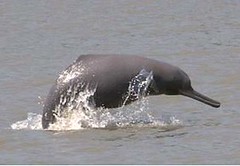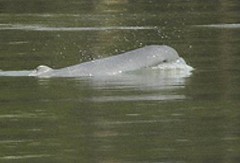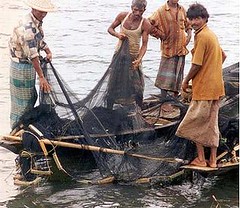 孟加拉政府日前在桑達本(Sundarbans)世界最大的紅樹林生態系中,設立了三個淡水豚的保護區。
孟加拉政府日前在桑達本(Sundarbans)世界最大的紅樹林生態系中,設立了三個淡水豚的保護區。
保護區於1月29日正式成立,旨在保護亞洲僅存的兩種淡水豚:恆河豚(Ganges River dolphin,Platanista gangetica gangetica)與伊河豚(Irrawaddy dolphin,Orcaella brevirostris)。這兩種淡水豚都沒有全球族群量評估的資料,在過去分佈範圍中的許多地區,也已經失去蹤跡,但仍有225隻的恆河豚和450隻的伊河豚存活在桑達本地區。
在世界自然保育聯盟(IUCN)的瀕危物種紅皮書中,恆河豚的保育狀態屬於瀕危(EN),而伊河豚則為易危(VU)。
 因為興建水壩、有毒物質汙染以及非永續漁業等諸多人類活動,破壞了牠們的棲息地,使得淡水豚成為世界上生存最受威脅的生物之一。族群分布的調查發現,恆河豚和伊河豚的活動區域,均是人類利用最頻繁的水域。
因為興建水壩、有毒物質汙染以及非永續漁業等諸多人類活動,破壞了牠們的棲息地,使得淡水豚成為世界上生存最受威脅的生物之一。族群分布的調查發現,恆河豚和伊河豚的活動區域,均是人類利用最頻繁的水域。
位在桑達本紅樹林東部的Dhangmari、Chandpai及Dudhmukhi地區的三個保護區,包含了31.4公里的水道,共10.7平方公里的面積。這些新保護區的設立,是由設立在美國布朗克斯動物園的「國際野生物保育協會」(Wildlife Conservation Society,WCS),經執行孟加拉鯨豚多樣性計畫(Bangladesh Cetacean Diversity Project)後所選定的。
有鑑於中國長江江豚,儘管已在長江存活了1千多萬年,卻因逃不過魚網的糾纏與棲地品質的劣化而全數滅絕,2002年之後再也沒有目擊紀錄。WCS表示,透過保護區所形成的保護網,可以避免僅存的淡水豚遭到滅絕。
自1990年早期即在孟加拉進行鯨豚研究、現任WCS亞洲淡水與海岸鯨豚保護計畫主持人的Brian D. Smith表示,設立保護區是保育恆河豚與伊河海豚的第一步。
孟加拉的海豚主要死因是漁網糾纏而死、以及牠們的食物如魚或甲殼類等,遭養蝦業用來捕蝦苗的細網因混獲(by-catch)而抓光。而存活的淡水豚仍受到海平面上升造成的鹽度改變,與上游河道改變所沖下來的沉積物所威脅。
Smith表示,作為生態系等級的指標生物,淡水豚可以反映氣候變遷下人與野生動物互動的狀況,提供了保育和永續發展廣大的潛力。
三個保護區既已正式設立,孟加拉政府將發出公告,禁止當地漁民進入保護區。
孟加拉林業局的林業與野生動物專家Tapan Kumar Dey博士表示,關鍵在於當地人的參與。
 為了達成這個目標,孟加拉鯨豚多樣性計畫團隊從18日開始,在桑達本紅樹林週邊的社區舉辦名為「Shushuk Mela」的搭船賞豚活動。而Shushuk 即是當地語言對恆河豚的稱呼。
為了達成這個目標,孟加拉鯨豚多樣性計畫團隊從18日開始,在桑達本紅樹林週邊的社區舉辦名為「Shushuk Mela」的搭船賞豚活動。而Shushuk 即是當地語言對恆河豚的稱呼。
長達一個月的活動,希望提升對新保護區的認識,吸引當地漁民及其他族群討論所需的管理工作,以確保人與海豚的共存。
桑達本的新保護區亦將為其他生存受威脅的水生生物提供保護,如河龜(river terrapin)、日鷉(masked finfoot)與小爪水獺(small-clawed otter)。
孟加拉是公認淡水豚生存的關鍵地區,2009年4月在Smith等人的努力下,WCS宣布發現全球最大、數量將近有6000隻的伊河豚族群。這族群的一部份和稀有的恆河豚是重疊的,恆河豚的族群分佈一路延伸至尼泊爾喜馬拉雅山的山腳下。
Bangladesh has established three new wildlife sanctuaries for endangered freshwater dolphins in the world's largest mangrove ecosystem, the Sundarbans.
Officially declared on January 29, the sanctuaries are intended to protect the last two remaining species of freshwater dolphins in Asia - the Ganges River dolphin, Platanista gangetica gangetica, and the Irrawaddy dolphin, Orcaella brevirostris.
While there is no global population estimate for either species, both have disappeared from major portions of their range but still survive in the Sundarbans. Rough estimates indicate populations of about 225 Ganges River dolphins and 450 Irrawaddy dolphins there.
The IUCN Red List of Threatened Species lists the Ganges River dolphin as Endangered and the Irrawaddy dolphin as Vulnerable to extinction.
Freshwater dolphins are among the most threatened animals on Earth because human activities, such as dam construction, toxic contamination and unsustainable fisheries, disturb their habitat. Population surveys find Ganges River and Irrawaddy dolphins living in the very waterways where human activities are most intense.
The three sanctuaries - in the Dhangmari, Chandpai and Dudhmukhi areas of the Eastern Sundarbans mangrove forest - safeguard 19.4 miles (31.4 km) of watery channels with a total area of 4.1 square miles (10.7 sq km).
The newly-protected areas were identified as dolphin hotspots by the Bangladesh Cetacean Diversity Project, a project of the Bronx Zoo-based Wildlife Conservation Society.
These small areas could be the safety net that prevents extinction for these species, says the WCS, in view of the recent extinction of another freshwater dolphin - China's Yangtze River dolphin whose last confirmed sighting was in 2002. Fatal entanglement in nets and habitat degradation killed off this species after it had survived in the Yangtze River for more than 10 million years.
"Declaration of these Wildlife Sanctuaries is an essential first step in protecting Ganges River and Irrawaddy dolphins in Bangladesh," said Brian D. Smith, director of the WCS's Asian Freshwater and Coastal Cetacean Program, a scientist who has been studying cetaceans in Bangladesh since the early 1990s.
The Bangladesh dolphins are threatened by fatal entanglements in fishing gear and depletion of their prey from the by-catch of fish and crustaceans in fine-mesh "mosquito" nets used to catch fry for shrimp farming.
The surviving dolphins are at risk from increasing salinity and sedimentation of the rivers caused by sea-level rise and changes in the availability of upstream freshwater flow.
"As biological indicators of ecosystem-level impacts, freshwater dolphins can inform adaptive human-wildlife management to cope with climate change, suggesting a broader potential for conservation and sustainable development," said Smith.
Now that the three sanctuaries have been officially declared, Bangladesh officials will post signs so that local fishermen do not enter the protected areas.
Dr. Tapan Kumar Dey, conservator of forests and wildlife with the Bangladesh Forest Department, said, "A critical component will be to engage local human communities."
To achieve that goal, starting on Saturday, the Bangladesh Cetacean Diversity Project will bring a boat-based dolphin exhibition called the "Shushuk Mela" to local communities bordering the Sundarbans mangrove forest. Shushuk is the local word for the Ganges River dolphin.
This month-long traveling exhibition is intended to raise awareness about the new wildlife sanctuaries and engage local fishermen and other community members in discussions on adaptive management practices needed to ensure human-dolphin coexistence.
The new wildlife sanctuaries in the Sundarbans will provide protection for other threatened aquatic wildlife, including the river terrapin, masked finfoot, and small-clawed otter.
Bangladesh has been recognized as a critical place for freshwater dolphin survival. In April 2009, based on research by Smith and others, the Wildlife Conservation Society announced the discovery of the world's largest population of nearly 6,000 Irrawaddy dolphins in the country. A portion of this population shares habitat with the endangered Ganges River dolphin, whose range extends all the way upstream to the shadow of the Himalayas in Nepal.





